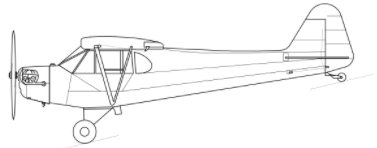Back to Aerodynamic Design of Aircraft with Computational Software
Back to overview: Preamble Exercises and Projects
Chapter 3[pdf]: 3.1 Introduction - Mapping Planform to Lift and Drag 3.2 Computational Vortex-Lattice Methods 3.3 Planform Design Studies with VLM 3.4 Wings for High Speed
Tutorial: —
Review questions
- Look at the Biot-Savart equation (3.5). Where does it produces infinite velocities? Consider now a VLM model with a symmetric main wing ahead of a vertical tail in the symmetry plane and a horizontal stabilizer. The model assumes that the trailing vortices follow free stream streamlines. Consider the Piper Cub J-3 in the sketch below, from Wikipedia. Sketch in the angles of attack where we expect trouble from trailing vortices hitting collocation points or bound vortex midpoints. Yet the Cub flies just fine. Discuss the effect of the fuselage. In zero sideslip, the wing horseshoe trailing leg in the symmetry plane should not create problems in the force calculation anyway. Why?

- Assume that a pair of wingtip vortices Gand -G, separated by wing span b (actually, they will converge somewhat from the wing tips) are infinitely long and horizontal. How fast do they sink – or rise? Using the simplest constant-strength Prandtl lifting line model, compute G for a Boeing 747 at take-off weight around 350 metric tons. You will need more data, easily available. Constant strength is wrong; re-do the calculation assuming elliptic lift distribution; that model sheds a variable-strength wake. Assume that it rolls up so all vorticity from the right half is concentrated to the wing tip trailing streamline. What is its strength?
VLM computations
The script tor1.m computes a quadrilateral wing defined by AR, taper ratio ct/cr , quarter-chord sweep angle Sweep, dihedral Dihed, and Twist for some airspeed, altitude, and angle of attack a. It produces a row in a table of the parameters (angles in radians)
AR ct/cr Sweep Dihed. Twist alpha
and a corresponding row in a table of the force and moment coefficients
CL CD CY Cl Cm Cn
tor1(AR,tap,swe,dih,twi,alt,airspeed,alpha,foil1,foil2,resimn,resimx)resimn and resimx define refinements of the initial paneling:
nx = 2(res-1) nx0 for res = resimn… resimx.
so resimn = 2 and resimn = 4 runs original, doubled, and quadrupled paneling used to extrapolate the results, in VLM_e.m described below.
- Check how the VLM estimates for CL, Cm converge with the number of vortices. Run with script tor1.m an AR 8 rectangular wing with symmetric profile and
Nx = 2k, k = 1,….. and Ny = 4Nx, a = 5 deg.
Use resimn = resimx = 2,3,4,5. Plot CL, Cm and CD vs. 1/Nx. Theory shows that
CL(1/Nx) = CL(0) + C1/Nx + smaller terms.
This allows extrapolation to Nx = Infty:
CL(0) = 2 CL(1/(2Nx)) – CL(1/Nx)
is usually a better approximation than even CL(1/(4Nx)) and much cheaper since the work grows like Nx4. The extrapolation can be continued with results from 4 Nx, 8 Nx, … (but 8 Nx costs 4000 x the compute time of Nx). Systematic mesh refinement with at least three levels is a due diligence check that the convergence follows the theory so bad results from under-resolution, ill-conditioning, or “close encounters” can be spotted. The functionVLM_e.mperforms calculations of force and moment coefficients for a sequence of refinements of a user-defined initial coarse paneling.
- Then try a straight wing with AR 2, 4, 6, 8, 10. Run an alpha sweep withtor1.m and check dCL/da (small a) vs. the formula in Ch 3. The script ARsweep.m runs a list of AR and a using
tor1.mwhich in turn uses VLM_e.m and produces tables partab and restab with rows described above. Your job is to compute CL,a from the table.
- The script
tor1.mcomputes a quadrilateral wing with sweep, taper, and twist. Your job is to experiment with sweep and taper for an untwisted wing. Modify ARsweep.m to make an (AR, taper, a) sweep and fit
CDi = CD0i + k CL2
to the computed points for each (AR,taper). The wing (induced drag) efficiency factor is e = k/(p AR) where lifting line theory predicts that emax= 1 for an elliptical flat wing.
Fix AR at 6. Then run a quadrilateral tapered wing with ct/cr = [0.3, 0.7, 1] and quarter-chord sweeps [0,30,60]o. Note the e and CD0i so computed as well as CL,a. Before analyzing the data, add a rough estimate of CD0,viscous of 150 cts to CD0i. Show that the best L/D (which determines best glide slope) is LoDmax = 1/sqrt(k CD0tot). Which wing has best glide slope?
- The file
GAV.mhas a Tornado model for a Piper Cub-like generic general aviation airplane and its weight and CG-location. What angle of attack and elevator angle will trim it for straight and level flight at sea level and TAS 35 m/s? Suppose CD0v = 0.0150. What thrust is required? First, neglect the elevator influence on lift to find a, then for this a find the correct elevator angle ele. A more accurate procedure is to assume “linear aerodynamics”. Compute the derivatives CL,a , Cm,a, CL,ele and Cm,ele from a computed table produced by (a,ele)-sweep and solve the linear system
qS(0 + α CL,α + ele CL,ele) = W, qScMAC (0 + α Cm,α + ele Cm,ele) = 0
